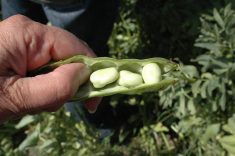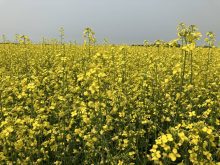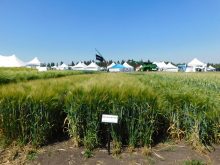“As we use more super-terminals and unit trains, there’s more risk that a major part of a shipload of grain originates in a single area where fusarium has infected grain”
It started in Manitoba’s Red River Valley in the early 1990s, has been moving west ever since, and it’s finally here.
Fusarium has become a fact of life in southern Alberta and it’s no surprise that it struck quite hard in last August’s wet weather. Worse still, there’s a new race of Fusarium graminearum among the fusarium-damaged kernels (FDK) and it produces higher levels of the fusarium toxin deoxynivalenol or DON, which could mean challenges for grain marketers.
Read Also

New crop insurer policy enables easier startup for faba beans
Agriculture Financial Services Corporation updated its normals for faba beans, which may open the door for more Canadian producers to feel comfortable growing the pulse crop in the future.
Randy Clear of the Canadian Grain Commission Microbiology Technology Division says last year’s southern Alberta grain samples showed more damage than in the past. About 10 per cent of Hard Red Spring wheat, around 18 per cent of durum in District 2 in the centre-south of the province, and just over eight per cent of durum in District 1 in the southeast corner of the province showed fusarium damage.
“Durum is the class of wheat that’s most susceptible to fusarium; Soft White and CPS are similar,” says Clear. “Grain growers in southern Alberta have to assume that there is inoculum either in their fields or that inoculum can blow in from neighbouring fields. As long as weather during flowering and grain filling follows normal patterns, it’s not a real problem. It’s when you get wet weather and have high levels of inoculum the risk of fusarium damage is high.”
Areas such as the Highway 2 Corridor and around Edmonton, where wet summers are common, don’t have a lot of fusarium inoculum at present. Clear advises growers in those areas take all possible precautions to avoid bringing in the fungus. Use seed with non-detectable fusarium levels and avoid bringing in seed from the irrigated areas of the south or other affected areas, such as Manitoba. “There’s no way to keep fusarium out,” he says. “But you can buy time.”
SEVERAL STRAINS
In the irrigated areas, about a third of the fusarium head blight was caused by Fusarium culmorum. This species is found elsewhere, but it causes very little head blight anywhere other than southern Alberta – it causes two per cent of fusarium damage in Manitoba. Clear doesn’t know why. Spores of F. graminareum spores are shot into the air from crop residue and carried by air currents to the grain heads, but those of F. culmorum have to be splashed up from residue to the grain head. Once on the head, F. culmorum causes fusarium head blight, just like F. graminearum.
Clear’s team also found a new, more troublesome strain of F. graminearum in Alberta samples. It produces significantly more vomitoxin than the current strain, about twice as much toxin in the lab, but only 10 or 15 per cent more in the field. This new strain has spread from the east, apparently due to some advantage. “The new strain of fusarium is in samples from all Western Canada,” says Clear. “It makes up 60 per cent of fusarium in Manitoba, 100 per cent in PEI, but virtually none in Ontario. We don’t know what gives it a fitness advantage in some environments.”
The new strain is known as the 3-A DON chemotype. The older strain is 15-A DON. Scientists distinguish them by small differences in the chemistry of DON although their main practical difference is DON level. Higher DON production could be a challenge in grain marketing because buyers specify maximum levels of DON rather than fusarium-damaged kernels (FDK.) A change in the DON levels caused by each percentage of FDK could force a change in grading standards.
NOT ALWAYS VISIBLE
Grain can also be infected with fusarium and contaminated with DON without showing any signs of blight. Heads can be infected if there’s wet weather any time from flowering until harvest, says Clear. Later infection causes fewer symptoms, but up to half the DON in a grain sample can come from grain that appears normal. It could mean problems in meeting buyers’ maximum DON specs.
“As we use more super-terminals and unit trains, there’s more risk that a major part of a shipload of grain originates in a single area where fusarium has infected grain,” says Clear. “That could mean unexpectedly high DON levels. We have to be very vigilant with export grains and monitor rail cars and lake vessels carefully.”
Clear says rapid tests for DON levels take only 40 minutes, but samples have to be delivered to CGC labs, and accurate sampling is a constant challenge. “Blending is a blessing for all growers, but the flip side of that is that fusarium anywhere in Canada affects all growers. The smaller the area affected by fusarium, the better for all growers.”














